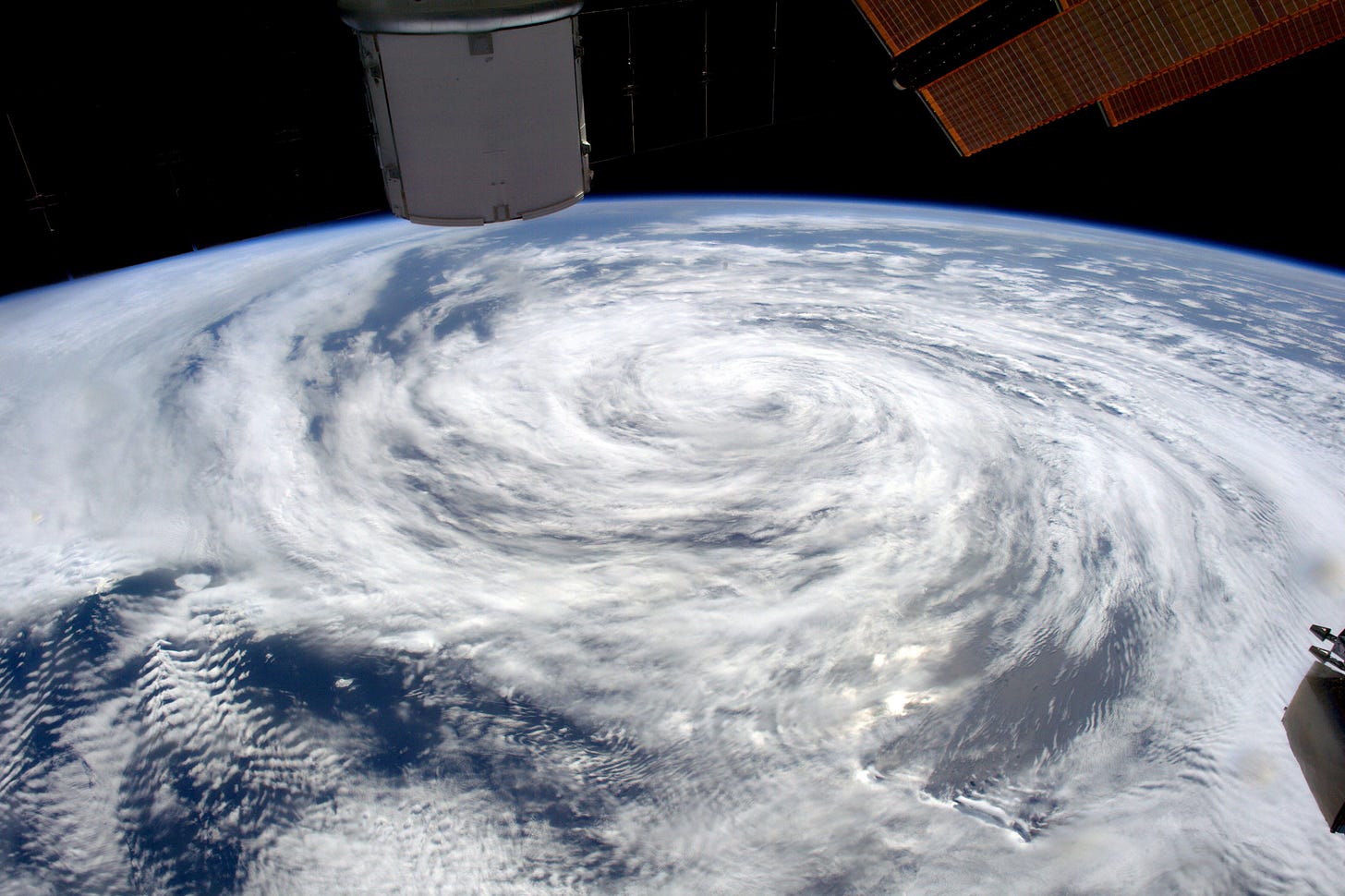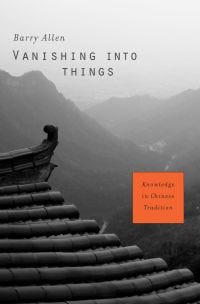Have you ever gazed at a cloud and wondered how it felt the world spinning beneath it?
That's the kind of expansive thinking we're diving into this week. We're exploring the world of Chinese strategic assessment, where the future isn't a labyrinth of equally possible paths to evaluate from a distance, but a present symphony you learn to hear, feel and vanish into.
Don’t be fooled by the implied volatility of US Equities being at historical lows. We live in a world increasingly defined by chaos and complexity. Like a warm promiscuous soup, our era is marked by a high entropy state where global energy dissipates rapidly and chaotically, in an increasingly fragmented and interconnected whole.1
This pervasive fragmentation and disorder calls for new lenses through which to view global dynamics, that embrace the fluidity and multifaceted nature of market and power dynamics today.
An alien object to make sense of
In Western philosophical tradition we always approached truth and knowledge like detectives.
Descartes started his rational inquiry by separating the thinking subject (res cogitans) from its object (res extensa). Operating within a stream of (logically) exclusive choices, we piece together clues and construct a detailed analytical picture. Dilemmas and trilemmas have a role to play in the models that shape our action, but in the public discourse around what we know, paradox needs to be treated rather than embraced.
After all, isn’t more knowledge always better than less?
Some argue with Kelly2 (2016) that there’s an inevitable future which can be foreseen (epistemic optimism). Others share Taleb’s despondency about the complexity of such a chore: especially when outlier “black swan” events are involved.3 Nonetheless, we’re tasked everyday to make sense of propositions such as: “There’s a 60% chance Trump will become the next US President”.4
Probability is the most important concept in modern science, especially as nobody has the slightest notion what it means.—Bertrand Russell, 1929 lecture.
Any superposition of plausible outcomes is tamed with the use of probabilities, or for the more sophisticated observers with self-consistent probabilities distributions (with well-defined mean, variance, skewness, kurtosis… and other higher-moments).

In the frequentist statistical discourse, they represent an objective measure. In the classical sense, dating back since Laplace (1814), it’s the intuitive notion of distributing over “events of the same kind” that does all the heavy-lifting of a theory of chance. Pierce and Popper (1957) similarly regarded probabilities as objective “propensities”. Although vaguely defined, they are physical properties of entities in the real world, tendencies of certain phenomenas to yield others (cf. Interpretations of probabilities, SEP).
Alternatively, in the Bayesian approach, probabilities mirror the relative weight of subjective beliefs networks. The focus shifts on how these networks are updated. The epistemic matter at hand is nonetheless unchanged.
The philosopher and the novelist might warn us that outside the constrained environment of casinos and computer simulations, “events of the same kind” are utterly rare, especially when humans are involved in the loop and when the stakes are high. In the simplest of terms, if all happy families are alike; each unhappy family is unhappy in its own way.
Nowadays, it seems like the practicing statistician and the philosopher have moved their offices as far as possible to avoid bumping into each other. Western theories of knowledge tend to be fix on statements and beliefs.
This contemplative, logocentric posture was inherited from Greek antiquity. The remark that this attitude seems “counterproductive for understanding the contribution knowledge makes to the technical accomplishment of our civilisation” is the starting point of the poignant book by Barry Allen’s Vanishing into Things: Knowledge in Chinese Tradition (Harvard University Press, 2015).
The big picture has you in it
In traditional Chinese thought, the emphasis of knowledge lies in its purpose. The question “Can the future be predicted?” is addressed slightly differently. The outlook is optimist. While the distant future is impossible to predict, the immediate future - the impending now - “can be sensed through a heightened situational awareness”.5
Strategy - navigating knowns and unknowns in an adversarial setting - is interpreted less of a game of cards or chess and more like being a master musician. You don't just read and analyse the notes; you immerse yourself in the whole melody, feeling its rhythm and anticipating the next harmonious shift. You build and feel from a place of comprehensive anticipation of your personal history, present emotional state and forward-looking desires.
Comprehensive was a highlighted word in an (unclassified) report on the “The Chinese Military’s Strategic Mind-Set” (2007): the power-base of the state and its enemies is looked as a whole. Stratagem, or how an inferior force may overtake a superior one with the least effort, is the value at stake.
This habit of looking at things holistically is a major feature of Chinese strategic assessments. It is not always done in U.S. assessments […] Winning by stratagem has always “been the main idea of traditional Chinese strategic thinking… [It entails] the use of limited force to achieve victory or to realize the aim of the war.” In contrast, Western thinking pays more attention to contests of strength, emphasizing direct confrontation or force-type models.
Opening up to the big picture
If we look at the US Government’s self-assessment (2009) of its structured analytic techniques,6 the focus seems to be precisely in overcoming the biases that come with a narrow and intense focus: inviting contrarian opinions, high-impact/low-probability analysis and divergent brainstorming are all explored.
In scenario analysis, which “systematically explores multiple ways a situation can develop when there is high complexity and uncertainty”, the focal point is centred by “selecting by consensus the two most critical and uncertain forces and converting these into axes or continua with the most relevant endpoints assigned”. Policymakers are actively invited into forecasting and are tasked to consider how current decisions or strategies would fare in each of the four worlds.
This offers a very good example of the power of Stories with Four Characters, or 2x2 matrices, which we have already reviewed here.
Reading between the lines of the report, the conclusions are clear. One needs to actively break free of what Bourdieu called habitus: speaking that renders any work of imaginative analysis completely illusory. Analysis needs to escape all the fearful “this go without saying” common to a group in power.
Historians can’t stop at collecting and ordering documents. Forecasters cannot afford to focus on highly self-serving worldviews from an isolated observer’s standpoint.
It won’t ever be sufficient to navigate the entangled global playground.
Paths of least resistance
Chinese forecaster will naturally takes an holistic approach. In Eastern worldviews, interdependent relationships come before independent entities. The culturally inherited mental models, “oldest stories stories available to fall back into” don’t have four pairwise anti-thetical elements, but mutually interlinked five agents.
In a recent conversations and workshops with a Korean friend, we reviewed Richard Nisbett’s studies on The Geography of Thought: How Asians and Westerners Think Differently...and Why (2003).
Imagine a landscape painting, to the Eastern eye, the entire canvas is perceived as one, with the interplay of mountains, lakes, and the sky. The focus of Eastern students, Nisbett observed, was spent for longer on the background than on the foreground with respect to their American counterparts. It’s the verbs not the nouns that guide conscious logical exploration.
Understanding always aims to take advantage of the present conditions. Risk and opportunity coexist. In changing circumstances, your outlook should adapt and vary, just like an orchestra adjusting its tempo during a performance.
Conflict in the physical, information, and perception realms leaves a wide space for the application of strategy. Remember the Stieglitz et al. study about “Adaptation and inertia in dynamic environments” (2016)? It outlines the rhythm of change – how often things move (frequency), in which direction, and how much they shift (magnitude).
They find that flexibility yields superior performance only if the respective dynamic economic context of the firm is “characterized by persistent trends and by large, infrequently occurring structural shocks” (p.1854). If, however, the economic context of the firm is characterized by “frequent directional changes... with fleeting opportunities” (p.1854) the competitive advantage accrues to “inert organizations that restrict exploration” (p.1854) because they can leverage the benefit of consistent focus on those actions that yield good average payoffs “independent of environmental volatility” (p.1854) (Simandan, 2018)
Vanishing into things
Further, here's a mind-bending concept. Zìran (自然) translates to "vanishing into things". It's about letting go of your rigid perspective and becoming one with the situation. Allan’s book or Simandan’s article are excellent philosophical explorations, but here’s also a great video exploration of the concept.
Ziràn asks us to consider the overall energy of the system. Not just your own min-max for the most economical actions, but the efficient boundary conditions for the whole system.
Imagine a chameleon blending into its surroundings. By becoming deeply attuned to the present moment, the Chinese advocate sensing the global "propensity" of the situation – or where the flow is taking them. If this sounds para-scientific, to feel free to be skeptical; but I would compare it to how with Popper and Pierce we’ve previously defined probabilities.
Our minds can grasp the subtle influences, the invisible clues that foreshadow the incipient forces, by recognising what is lacking a completed form.
By understanding the rhythm of feeling the beat, Chinese strategists advocate anticipating the music of the future, by playing it not by predicting its exact melody.
So, the next time you face a challenge, take a deep breath and try a little zìran.
Let go of the need for absolute certainty, and instead, focus on feeling the flow of the situation: what is the path of least resistance leading you?
What are the subtle tells foreshadowing? What’s the counter-intuitive perspective you might be ignoring? How can you act effortlessly to achieve your goals?
Until the next cloud,
David
Parag Khanna aptly described it in his recent “The Coming Global Entropy” (Noema, 2024). The research echoes the famous work by Robert Kaplan “The Coming of Anarchy” (The Atlantic, 1994), where Kaplan argued that scarcity, crime, overpopulation, tribalism, and disease were rapidly destroying the planet's social fabric.
N. Taleb, The black swan: The impact of the highly improbable, 2007.
OddsChecker’s Live Odds (last checked: 14-06-2024).








